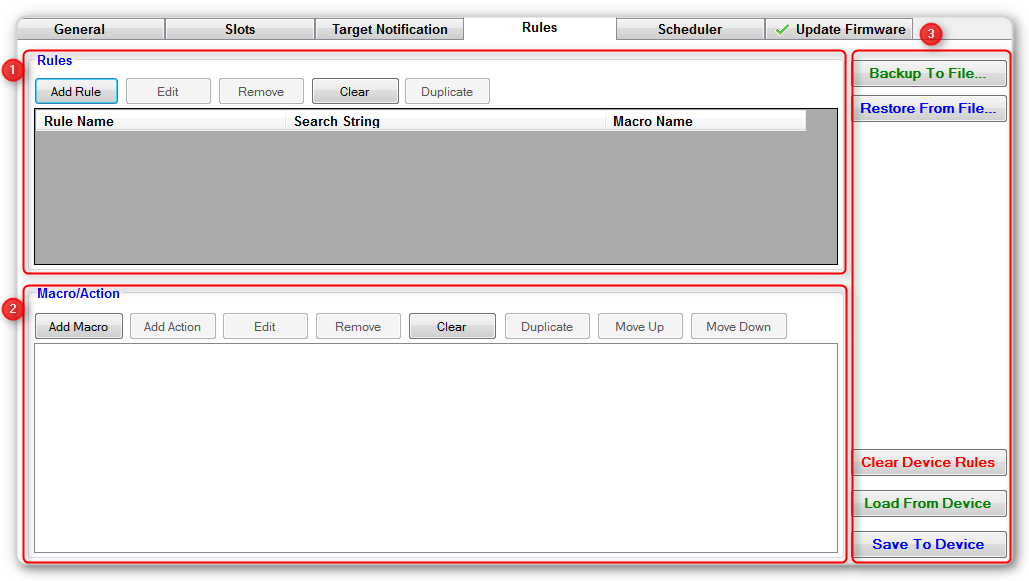User Tools
Sidebar
Navigation
hardware:rules
Table of Contents
Rules (Event Triggered Macros)
Overview
Rules allow each device on the CFLink network to perform actions based on string matching of outgoing data on the CFLink bus.
For example, you can create a rule that when a specific dry contact on a SW16 is closed, a custom macro is triggered.
Rules are stored on the device that sends the commands. So if you want to perform a rule when a SW16 dry contact closes, you store the rule on the SW16.
If you wanted to perform a rule when data arrived on a TCP socket in the LAN Bridge, you would store the rule on the LAN Bridge.
If you wanted to perform a rule when the resistance input of a MOD-IO8 changed, you would store the rule in the unit housing the module (DIN-MOD4 for example).
Rule Properties
A rule is defined with a name, search string and a macro to trigger.
- Name = A name given to the rule for your records. The name has no effect on anything, it's just a way to remember what a rule was created for.
- Search String = A search pattern to match an outgoing CFLink message (as well as incoming TCP/UDP packets for LAN Bridge rules). When this search pattern matches a message, the rule is triggered.
Search strings can contain wildcard match characters as follows:*(asterisk) means match any character zero or more times, until the next defined character in the search string is found, or until the end of the message..(period) means match any character a single time.
- Macro Name = The name of a macro to perform when the rule is triggered (when the search string matches any outgoing data)
Macro Properties
A Macro is defined with a name and a series of actions and delays.
- Name = The name of the macro. This is used by Rule definitions to call the macro to be performed.
- List Of Commands & Delays = One or more actions with a delay
- Command Data = The command data to send as part of the macro.
- Delay = The delay before the command data for this action is sent. This delay is sequential, meaning its the delay from the action above it, NOT a delay from the start of the macro. The delay occurs BEFORE the command is sent. Use a delay of 0 (zero) to instantly send the command data.
System Commander Rules Tab
The rules tab within System Commander allows you to create and add macros and rules to be run on your device. This tab is identical across all CommandFusion hardware that supports our Rules Engine.

A detailed explanation of how to program macros and rules can be found in our System Commander Quick Start Guide here.
1 - Rules
A rule watches for a specific event, then runs a macro when that event occurs.
2 - Macro/Action
A macro must always be created first, as a rule will trigger a macro. A macro is a pre-defined set of actions to be run when triggered by a rule.
3 - Buttons
Backup to File
This button allows you to backup your rules and macros to a local file. This can be file can be kept as a backup, or used to load the rules and macros onto a different device.
Restore to File
This button allows you to choose a locally stored backup file to load macros/rules onto the current device.
Clear Device Rules
Erases all rules all rules and macros from the current device.
Load From Device
Loads the rules and macros currently stored on the device and shows them in System Commander.
Save to Device
Saves all changes made to the device.
CFLink Protocol
For details on the CFLink protocol used to create and delete rules, please see the Rules Protocol wiki entry.
hardware/rules.txt · Last modified: 2015/12/23 00:26 by jarrod
